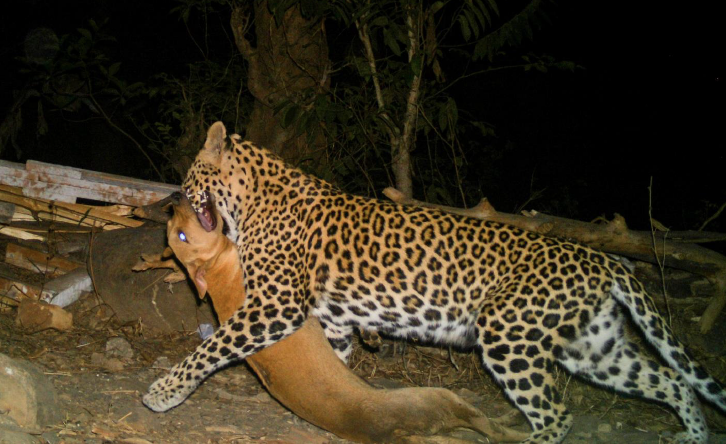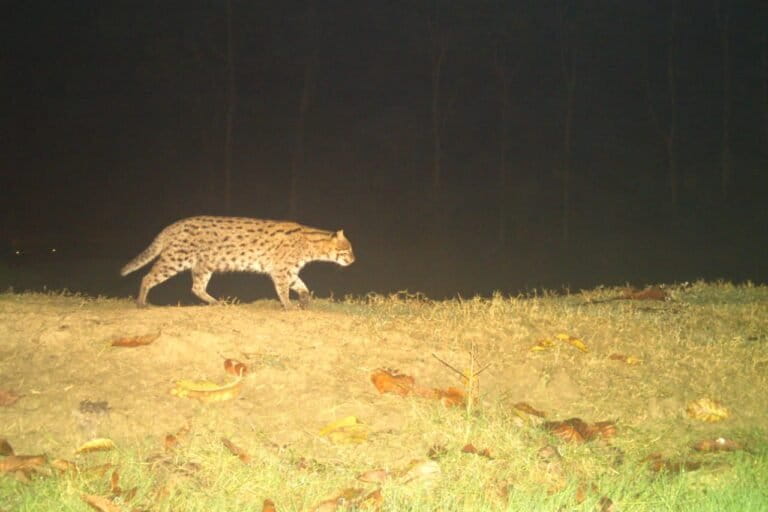- The leopards in Mumbai may have beneficial impact to the people of city, according to a recent study.
- By preying on stray dogs in and around Sanjay Gandhi National Park, leopards are reducing dog bite incidents and preventing deaths from rabies.
- Many variable factors need further study to verify this claim, suggest local experts.
- Increasing trend in wildlife research show how urban carnivores and humans can coexist peacefully.
Leopards in the Sanjay Gandhi National Park in the heart of Mumbai could be doing a public health service. A new study from the Ecological Society of America states that by preying on stray dogs in the region, the leopards are reducing dog bite incidents and preventing an estimated 90 human lives from dying of rabies each year.
There are approximately 35 leopards living in the 104 square km park, which encompasses a sizeable chunk of Mumbai’s geographical area. To the southwest of the park is the 16 square km Aarey Milk Colony — part of which is controversially being sought for a Metro train depot — a place that the big cats visit regularly. The leopards are usually perceived negatively by residents close to these areas given the regular cases of human-leopard conflict. However, this study puts a twist to the common perception and offers benefits of leopards in protecting the residents from dog bites and possibly even rabies.
The authors estimate that there are about 96,000 stray dogs in the city, one of the highest number in the world, which often bite humans and transmit rabies. Rabies is responsible for the deaths of over 20,000 people in India per year. In Mumbai specifically, the study cites an average of 74,603 bite cases reported per year among the population of 21 million.

“This abundance of stray dogs arises as a result of human tolerance and the hundreds of tons of uncollected refuse,” the study states.
There are 250,000 people living within 500 metres of the park’s periphery, who dispose off kitchen waste carelessly and attract dogs which, in turn, are easy prey for leopards at night.
This 500-metre belt of the forest edge is mainly where the leopards attack, the study notes, based on expert opinion of wildlife ecologists as well as 10 sightings of leopards outside the park.
The forest belt forms an area of 43 square km, with an average density of around 17 dogs per square km. This adds up to a total of 730-760 dogs, which constitute about half the number the leopards consume.
Leopards eat wild and domestic prey
A 2015 survey of SGNP by wildlife biologist Nikit Surve, now with the Wildlife Conservation Society in Bengaluru, which focuses on the leopards’ population, prey and food habits, found: “The high density of dogs in the periphery of the Park is also reflected in the leopards’ diet. Dogs alone contributed 24.46 per cent of the total biomass consumed in their diet. Domestic prey contributed 43 per cent whereas wild prey contributed to 57 per cent of leopards’ diet in terms of relative biomass consumed. The study suggests that the leopards are dependent on both wild as well as domestic prey in the study area. Leopards can share spaces with humans even amidst urban environs as long as prey populations (both domestic and wild) remain sufficient and their habitat is protected.”
The current study assumes that a leopard consumes 4.7 kg of meat every day and 35 leopards will kill about 1,500 dogs a year. It then evaluates these big cats’ role in stray dog management in financial terms by comparing it against the Brihanmumbai Municipal Corporation’s ongoing dog sterilisation programme, which is conducted at a cost of USD 11.90 (approximately Rs. 780) per dog (www.wsdindia.org) and estimates a saving of USD 18,000 (Rs. 1.17 million) in sterilisation costs, which is equivalent to around 8 percent of Mumbai’s existing annual sterilisation budget USD 208,000 in 2015.

“Leopards can save human lives”
“Under one set of assumptions, the presence of leopards in this highly urbanized area could save up to 90 human lives per year,” state the authors.
The study calculates that rabies vaccinations and post-exposure treatments cost on average USD 33.75 (Rs. 2,200). It points out that this represents a substantial expenditure for the majority of bite victims, who typically live below the poverty line.
Asked whether the study has made a common mistake in conflating the area of what is Greater Mumbai, the city proper occupying 480 sq km, with the very much larger Mumbai Metropolitan Region of 4,355 square km, and correspondingly citing the city’s population at 21 million instead of around 14 million, lead author Alexander Braczkowski from the University of Queensland in Brisbane, Australia, replied: “Your points don’t alter the point of the study — our data shows that if leopards were to be taken out of the system and dog numbers were to be the same as those away from the park then you could expect an exponential rise in dog bites!”
“All our estimates are made on current population and dog numbers. The expanding human population information is just background and doesn’t have anything to do with the area of interest in our study,” he clarified.

More in-depth analysis needed
Local experts however feel that while there is beneficial information highlighted in the study, more indepth analysis and scientific basis is needed for verifying the claim.
Vidya Athreya, a wildlife biologist also with the Wildlife Conservation Society in Bengaluru who is probably India’s foremost authority on the leopard-human conflict which she has been studying since 2003, told Mongabay-India: “It is a very simplistic analysis with a lot of presumptions, so I would not take the findings, especially the rabies connection, seriously. What I would appreciate is that for the first time, the ecology of urban carnivores and the prey dynamics has been brought out into the open in an Indian context.”
Athreya also referred Mongabay-India to The Global Alliance for Rabies Control (GARC) which aims to eliminate deaths from canine rabies by 2030 more holistically. It treats rabies as a neglected disease of poverty, which is almost 100 per cent fatal, but can also be prevented with available vaccines. Its work centres around the One Health Approach where vaccinating dogs halts the disease at its source.
Krishna Tiwari, formerly with the Bombay Natural History Society and now the founder of the NGO Forest and Wildlife Conservation Society, had a more detailed response. “I think this study can’t be a confirmation but just an assumption as there is no scientific basis for the claim, and leopards can’t be at par with scavengers. The study is not convincing in its context.”

“How many stray dogs are there in Mumbai-Thane region (not just those areas abutting the Park)? How many cases of dog bite are reported in the entire region? And cases of rabies detected from dogs staying in and around SGNP?” he questions.
Dogs are smart
“Dogs aren’t so easy to prey on as they are smart, avoiding leopards by moving/shifting deep in crowded areas during dark hours and only returning back during the day. People are aware and keep their pets inside. And finally what is the negligible number of dogs taken by SGNP leopards?
The study doesn’t speak of ill-effects of long-term predation on dogs which can lead to behavioural changes and infectious diseases in leopards,” he added.
Citing research by the the initiative ‘Mumbaikars for SGNP’ launched in 2011-12 to understand and manage human-leopard encounters in the region, Tiwari said, “the present authors haven’t mentioned anything in detail on diet in their report. But a diet study done by Nikit Surve for this initiative showed that leopard prey more deer and less on dogs!”
Surve also critiqued the study for making a number of assumptions. “The figures may not work out,” he told Mongabay-India. “It is based on modelling and other factors.”
He adds,“People in developed countries may not understand how often people in India feed stray dogs. Not all of them are strays. Some feed but do not shelter them; others do both. They shelter them at night, when the leopards are on the prowl. You can’t have a model which takes into account every factor. Leopards also run the risk of contracting rabies or canine distemper which would cause them to have fits. This hasn’t been touched upon.”
Bilal Habib from the Wildlife Institute of India is more positive about the study, since there is usually a negative connotation attached to leopards because of incidents in urban areas involving killing of humans and livestock. . “This is a huge change in perception,” he told Mongabay-India. “It gives a total new dimension from a scientific viewpoint, which may influence politicians.”
He also cited how the absence of vultures throughout South Asia has led to the proliferation of feral dogs and how, similarly, the reduction in the number of kites in Delhi has led to this increase.
Leopards can coexist with humans
As the current study also underlines, wildlife ecologists are moving away from the concept of urban carnivores being a threat to humans towards a new paradigm where they can both coexist peacefully.
Athreya’s research too shows this direction. Her research objectives are described by Wildlife Without Borders as, “using knowledge-based interventions and working with important stakeholders so that human-leopard conflict can be reduced, especially attacks on humans. Her recent research has led to a better understanding of leopard ecology when they live among humans in agricultural landscapes. She is also very interested in the interplay between socio-politics of conflict and the role of cultural tolerance towards wildlife in India. Her work questions known paradigms of large cats living among humans. She believes that the persistence of large carnivores has much to do with the acceptance of local people towards these species.”

Habib draws the attention of Mongabay-India to two international studies which highlight the similar approach of peaceful coexistence of urban carnivores and humans. One, in 2016, is titled Paws without claws? Ecological effects of large carnivores in anthropogenic [manmade] landscapes. It concludes: “However, in large parts of the world, particularly in Europe, large carnivores live in and are returning to strongly human-modified ecosystems. At present, we lack a coherent framework to predict the effects of large carnivores in these anthropogenic landscapes.”
The other, in 2018, is The contribution of predators and scavengers to human well-being, of which Braczkowski is a joint author. The authors assert: “The benefits of predators and scavengers can be far reaching, affecting human health and well-being through disease mitigation, agricultural production and waste-disposal services. As many predators and scavengers are in a state of rapid decline, we argue that researchers must work in concert with the media, managers and policymakers to highlight benefits of these species and the need to ensure their long-term conservation. Furthermore, instead of assessing the costs of predators and scavengers only in economic terms, it is critical to recognize their beneficial contributions to human health and well-being.”
After all, the leopards of Mumbai need not be seen as a source of conflict alone.













